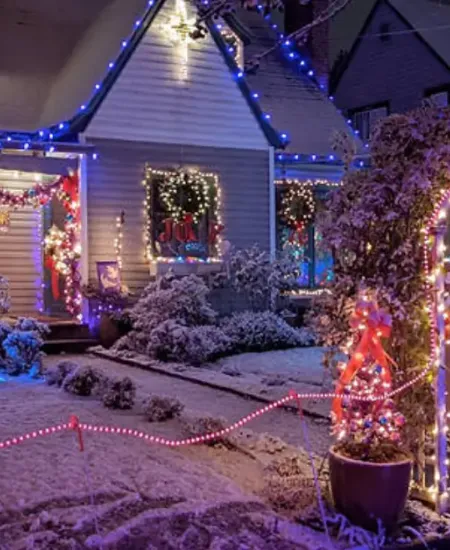Getting Started with Outdoor Light Displays: What You Need to Know
Remember the first time you decided to deck out your home with those twinkling outdoor lights for Christmas? I sure do. What began as a simple plan to add a bit of festive cheer turned into an epic saga of untangled wires, trips to the hardware store, and a newfound respect for electrical terms I’d never thought I’d need to know. If you’re nodding along, you’ve probably been there too. But worry not, because this year, we’re going to get it right together!
Understanding the power requirements for outdoor light displays isn’t just about making your home the brightest star on the block. It's about doing it safely and efficiently. So, grab a cup of hot cocoa, and let’s dive into the world of volts, amps, and wattages – and I promise to keep it as painless as possible.
Decoding the Jargon: Volts, Watts, and Amps
Before we get into the nitty-gritty of power requirements, let’s have a quick refresher on some basic electrical terms. Think of electricity like water running through a hose. Voltage (volts) is the pressure of the water, amperage (amps) is the flow rate, and wattage (watts) is the total power output, or how much water comes out of the hose. So in the world of outdoor lighting:
- Voltage is typically standard at 120 volts for outdoor lights in the U.S., but always check your specific light sets.
- Amps determine how much electricity the light string draws. More amps mean a heavier electrical load.
- Watts are what you get when you multiply volts and amps together (Watts = Volts x Amps). This is the total consumption of your light display.
Got it? Great! Let’s keep going.
Calculating Total Load for Your Glitzy Ambitions
Now that we've covered the basics, let's talk about how to calculate the total power needed for your lights without tripping your circuit breaker—a surefire way to put a damper on your holiday spirit. Here’s a personal confession: one year, I enthusiastically hooked up several strands of lights to a single extension, plugged them in, and...nothing. Yep, I’d blown a fuse. Lesson learned.
To avoid my past festive faux pas, you need to understand your home’s power capacity. Most household circuits are rated for either 15 or 20 amps. Here’s a simple way to figure out what you’re working with:
- Identify the amperage of your circuit (check your breaker panel).
- Calculate the total wattage of all the lights you plan to use (Watts = Volts x Amps for each string of lights).
- Ensure the total does not exceed 80% of the circuit’s capacity to avoid overload. (bkvenergy.com)
For example, if you’re on a 20 amp circuit, your max wattage would be 1920 watts (120 volts x 20 amps x 80%).
To keep things running smoothly, be sure to connect multiple strings properly without overloading circuits.
Choosing the Right Extension Cords and Timers
Extension cords aren’t just about reaching the far corners of your yard. They need to safely carry the electrical load. Opt for cords that are rated for outdoor use and can handle the wattage of your lights. And if your display would make the Griswold family proud, consider using multiple circuits to spread out the load. (cpp.org)
Outdoor light timers are another lifesaver—literally. They not only save you from the midnight dash in pajamas to turn off the lights but also manage energy consumption efficiently. Look for timers that can handle the total amps of your light setup. (thespruce.com)
LED vs Incandescent: A Bright Decision
Choosing between LED and incandescent lights isn’t just a matter of preference—it impacts power consumption massively. LEDs are not only cooler to touch, making them safer for densely packed displays, but they also consume up to 90% less energy than traditional bulbs. Plus, they're sturdier and last longer. Switching to LEDs was a game changer for my displays; not only did my electric bill thank me, but setting up became far more manageable due to their lower power requirements.
Preventive Measures to Keep the Season Bright
Here are a few quick tips to ensure your light display is not only stunning but safe:
- Regularly check the insulation on wires for any signs of wear and tear. (bhg.com)
- Use a GFCI outlet to help prevent electric shocks.
- Securely anchor lights and decorations against harsh winter winds.
- Never overload your electrical outlets—it’s a real fire hazard.
Lastly, always turn off your light display when you’re not home or when it’s raining heavily. It’s better to skip a few hours of dazzle than risk any accidents.
Wrapping It All Up
Well, there you have it! Whether you’re planning for a subtle shimmer or a spectacular showstopper, understanding the power requirements for your outdoor light display can save you a lot of trouble (and potential trips to the hardware store mid-decoration). I’ve certainly had my share of light-related learning curves, but with each year, it gets a little easier, especially now that I know what I’m up against electrically.
So, this holiday season, let’s make our homes gleam with the joy and safety of well-managed festive lights. Your neighbors might just thank you for the magical view—and your circuit breaker will definitely thank you for the break!
Subscribe to our email newsletter and unlock access to members-only content and exclusive updates.

Comments